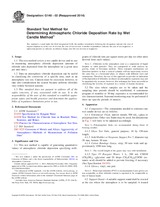We need your consent to use the individual data so that you can see information about your interests, among other things. Click "OK" to give your consent.
ASTM G140-02(2014)
Standard Test Method for Determining Atmospheric Chloride Deposition Rate by Wet Candle Method
STANDARD published on 1.11.2014
The information about the standard:
Designation standards: ASTM G140-02(2014)
Note: WITHDRAWN
Publication date standards: 1.11.2014
SKU: NS-57384
The number of pages: 4
Approximate weight : 12 g (0.03 lbs)
Country: American technical standard
Category: Technical standards ASTM
The category - similar standards:
Annotation of standard text ASTM G140-02(2014) :
Keywords:
atmospheric chloride deposition rate, wet candle method,, ICS Number Code 71.040.50 (Physicochemical methods of analysis), 77.060 (Corrosion of metals)
Additional information
| Significance and Use | ||||||||
|
3.1 This test method is capable of generating quantitative values of atmospheric chloride deposition specifying milligrams of chloride ions per square metre per day (or other units derived from such values). Note 1: Chlorides in the atmosphere exist as a suspension of
liquid droplets or solid particles. They are transported to solid
surfaces by gravity, wind, or brownian motions. These transport
mechanisms are direction-sensitive so that a vertical cylinder will
not necessarily receive the same flux as a horizontal plate, or
objects with different sizes and orientations. Therefore, the use
of this approach to provide an indication of the deposition of
chlorides on objects in atmospheric exposures may not be
quantitatively accurate; however, this technique has been
successful in classifying the severity of exposure in a variety of
marine locations.
3.2 The sites where samples are to be taken and the sampling time periods should be established. A continuous program of monthly or 30-day exposures is recommended for site characterization. Seasonal monitoring may be performed if there are specific periods of interest. |
||||||||
| 1. Scope | ||||||||
|
1.1 This test method covers a wet candle device and its use in measuring atmospheric chloride deposition (amount of chloride salts deposited from the atmosphere on a given area per unit time). 1.2 Data on atmospheric chloride deposition can be useful in classifying the corrosivity of a specific area, such as an atmospheric test site. Caution must be exercised, however, to take into consideration the season because airborne chlorides vary widely between seasons. 1.3 This standard does not purport to address all of the safety concerns, if any, associated with its use. It is the responsibility of the user of this standard to establish appropriate safety and health practices and determine the applicability of regulatory limitations prior to use. |
||||||||
| 2. Referenced Documents | ||||||||
|
We recommend:
Technical standards updating
Do you want to make sure you use only the valid technical standards?
We can offer you a solution which will provide you a monthly overview concerning the updating of standards which you use.
Would you like to know more? Look at this page.




 Cookies
Cookies
